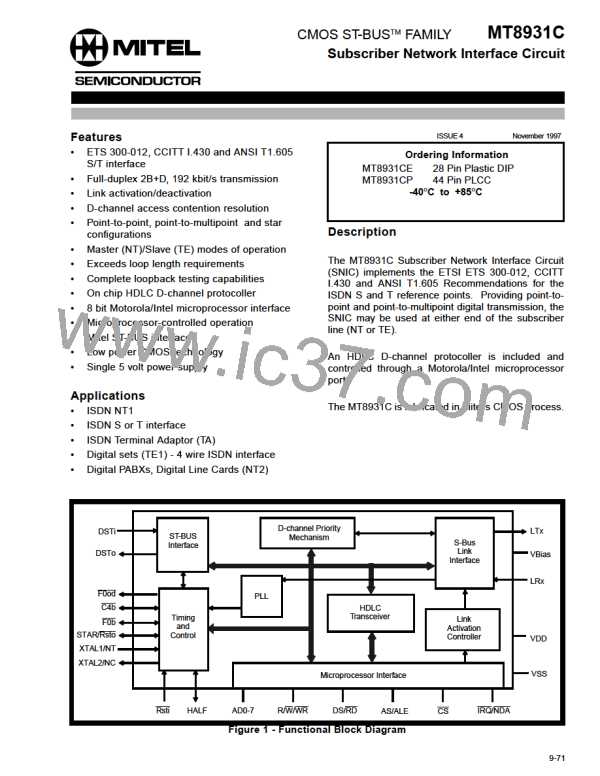MT8931C
Registers.
If one byte address recognition is
iii) Frame Abort
enabled, the address field is one byte long and it is
compared with the six most significant bits in
address recognition register 1. If two byte address
recognition is enabled, the address field is two bytes
long and is compared with the address recognition
registers 1 and 2. The address byte can also be
recognized if it is an all call address (i.e., seven most
significant bits are 1). If a match is not found, the
entire packet is ignored, nothing is written to the
Receive FIFO and the receiver waits for the next
packet. If the active address byte is valid, the packet
is received in normal fashion.
When a frame abort is received, the EOPD and FA
bits in the HDLC Interrupt Status Register are set.
The last byte of the aborted packet is written to the
FIFO with a status of “Packet Byte”. If there is more
than one packet in the FIFO, the aborted packet is
distinguished by the fact that it has no “Last Byte”
status on any of its bytes.
iv) Idle Channel
While receiving the idle channel, the idle bit in the
HDLC status register remains set.
All the bytes written to the receive FIFO are flagged
with two status bits. The status bits are found in the
HDLC status register and indicate whether the byte
to be read from the FIFO is the first byte of the
packet, the middle of the packet, the last byte of the
packet with good FCS or the last byte of the packet
with bad FCS. This status indication is valid for the
byte which is to be read from the Receive FIFO.
v) Transparent Data Transfer
By setting the Trans bit in the HDLC Control Register
2 to select the transparent data transfer, the receive
section will disable the protocol functions like Flag/
Abort/Idle detection, zero deletion, CRC calculation
and address comparison. The received data is
shifted in from the active port and written to receive
FIFO in bytewide format.
The incoming data is always written to the FIFO in a
bytewide manner. However, in the event of data sent
not being a multiple of eight bits, the software
associated with the receiver should be able to pick
the data bits from the LSB positions of the last byte
in the received data written to the FIFO. The
Protocoller does not provide any indication as to how
many bits this might be.
It should be noted that none of the protocol related
status or interrupt bits are applicable in transparent
data transfer state. However, the FIFO related status
and interrupt bits are pertinent and carry the same
meaning as they do while performing the protocol
functions.
ii) Invalid Packets
vi) Receive Overflow
In TE mode, if there are less than 25 data bits
between the opening and closing flags, the packet is
considered invalid and the data never enters the
receive FIFO (inserted zeros do not form part of the
valid bit count). This is true even with data and the
abort sequence, the total of which is less than 25
bits. The data packets that are at least 25 bits but
less than 32 bits long are also invalid, but not
ignored. They are clocked into the receive FIFO and
tagged as having bad FCS.
Receive overflow occurs when the receive section
attempts to load a byte to an already full receive
FIFO. All attempts to write to the full FIFO will be
ignored until the receive FIFO is read. When
overflow occurs, the rest of the present packet is
ignored as the receiver will be disabled until the
reception of the next opening flag.
In NT mode, however, all the data packets that are
less than 32 bits long are considered invalid. They
are clocked into the receive FIFO with “Bad FCS”
status.
9-86

 MITEL [ MITEL NETWORKS CORPORATION ]
MITEL [ MITEL NETWORKS CORPORATION ]